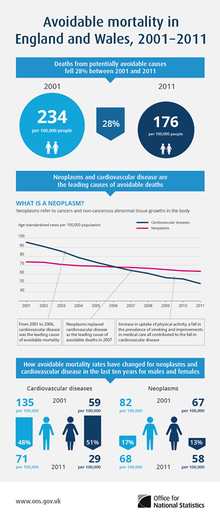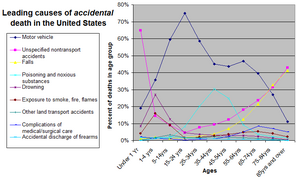Preventable causes of death

Preventable causes of death are causes of death related to risk factors which could have been avoided.[1] The World Health Organization has traditionally classified death according to the primary type of disease or injury. However, causes of death may also be classified in terms of preventable risk factors—such as smoking, unhealthy diet, sexual behavior, and reckless driving—which contribute to a number of different diseases. Such risk factors are usually not recorded directly on death certificates, although they are acknowledged in medical reports.
Worldwide[]
It is estimated that of the roughly 150,000 people who die each day across the globe, about two thirds—100,000 per day—die of age-related causes.[2] In industrialized nations the proportion is much higher, reaching 90 percent.[2] Thus, albeit indirectly, biological aging (senescence) is by far the leading cause of death. Whether senescence as a biological process itself can be slowed, halted, or even reversed is a subject of current scientific speculation and research.[3]
2001 figures[]
Leading causes of preventable death worldwide as of the year 2001, according to researchers working with the Disease Control Priorities Network (DCPN)[4] and the World Health Organization (WHO).[5] (The WHO's 2008 statistics show very similar trends.)
| Cause | Number of deaths resulting (millions per year) |
|---|---|
| Hypertension | 7.8 |
| Smoking tobacco | 5.4 |
| Malnutrition | 3.8 |
| Sexually transmitted diseases | 3.0 |
| Poor diet | 2.8 |
| Overweight and obesity | 2.5 |
| Physical inactivity | 2.0 |
| Alcohol | 1.9 |
| Indoor air pollution from solid fuels | 1.8 |
| Unsafe water and poor sanitation | 1.6 |
In 2001, on average 29,000 children died of preventable causes each day (that is, about 20 deaths per minute). The authors provide the context:
About 56 million people died in 2001. Of these, 10.6 million were children, 99% of whom lived in low-and-middle-income countries. More than half of child deaths in 2001 were attributable to acute respiratory infections, measles, diarrhea, malaria, and HIV/AIDS.[5]
United States[]
The three most common preventable causes of death in the population of the United States are smoking, high blood pressure, and being overweight.[6] Pollution from fossil fuel burning kills roughly 200,000/year.[1]
Accidental death[]

Leading causes of accidental death in the United States by age group as of 2002.[8]

Leading causes of accidental death in the United States as of 2002, as a percentage of deaths in each group.[8]
Annual number of deaths and causes[]
| Cause | Number | Percent of total | Notes |
|---|---|---|---|
| Preventable medical errors in hospitals | 210,000 to 448,000[9] | 23.1% | Estimates vary, significant numbers of preventable deaths also result from errors outside of hospitals. |
| Smoking tobacco | 435,000[7] | 18.1% | |
| Being overweight and obesity | 111,900[10] | 4.6% | There was considerable debate about the differences in the numbers of obesity-related diseases. The numbers reported in the referenced article have been found to be the most accurate.[11] |
| Alcohol | 85,000[7] | 3.5% | |
| Infectious diseases | 75,000[7] | 3.1% | |
| Toxic agents including toxins, particulates and radon | 55,000[7] | 2.3% | |
| Traffic collisions | 43,000[7] | 1.8% | |
| Preventable colorectal cancers | 41,400 | 1.7% | Colorectal cancer (bowel cancer, colon cancer) caused 51,783 deaths in the US in 2011.[12] About 80 percent[13] of colorectal cancers begin as benign growths, commonly called polyps, which can be easily detected and removed during a colonoscopy. Accordingly, the tabulated figure assumes that 80 percent of the fatal cancers could have been prevented. |
| Firearms deaths | 31,940[14] | 1.3% | Suicide: 19,766; homicide: 11,101; accidents: 852; unknown: 822. |
| Sexually transmitted infections | 20,000[7] | 0.8% | |
| Drug abuse | 17,000[7] | 0.7% |
Among children worldwide[]
Various injuries are the leading cause of death in children 9–17 years of age. In 2008, the top five worldwide unintentional injuries in children are as follows:[15]
| Cause | Number of deaths resulting |
|---|---|
| Traffic collision |
260,000 per year |
| Drowning |
175,000 per year |
| Viruses |
96,000 per year |
| Falls |
47,000 per year |
| Toxins |
45,000 per year |
See also[]
- Accidental death – Unnatural death caused by accident
- Alcohol and health – Health effects of drinking alcohol
- Short-term effects of alcohol consumption
- Long-term effects of alcohol consumption
- Lifestyle medicine – Branch of preventive medicine focused on self-care and health education applied to lifestyle choices
- List of causes of death by rate
- Health effects of tobacco § Mortality
- Preventive healthcare – Prevent and minimize the occurrence of diseases
- Public health – Preventing disease, prolonging life and promoting health through organized efforts and informed choices of society and individuals
References[]
- ^ Danaei, Goodarz; Ding, Eric L.; Mozaffarian, Dariush; Taylor, Ben; Rehm, Jürgen; Murray, Christopher J. L.; Ezzati, Majid (2009-04-28). "The Preventable Causes of Death in the United States: Comparative Risk Assessment of Dietary, Lifestyle, and Metabolic Risk Factors". PLOS Medicine. 6 (4): e1000058. doi:10.1371/journal.pmed.1000058. ISSN 1549-1277. PMC 2667673. PMID 19399161.
- ^ Jump up to: a b Aubrey D.N.J, de Grey (2007). "Life Span Extension Research and Public Debate: Societal Considerations" (PDF). Studies in Ethics, Law, and Technology. 1 (1, Article 5). CiteSeerX 10.1.1.395.745. doi:10.2202/1941-6008.1011. Archived from the original (PDF) on February 12, 2019. Retrieved August 7, 2011.
- ^ "SENS Foundation".
- ^ "DCP3". washington.edu. Archived from the original on 2013-01-28.
- ^ Jump up to: a b Lopez AD, Mathers CD, Ezzati M, Jamison DT, Murray CJ (May 2006). "Global and regional burden of disease and risk factors, 2001: systematic analysis of population health data". Lancet. 367 (9524): 1747–57. doi:10.1016/S0140-6736(06)68770-9. PMID 16731270. S2CID 22609505.
- ^ Jump up to: a b Harvard T.H. Chan School of Public Health (April 27, 2009). "Smoking, high blood pressure and being overweight top three preventable causes of death in the U.S." The President and Fellows of Harvard College. Archived from the original on 2012-11-22. Retrieved 2015-05-15.
- ^ Jump up to: a b c d e f g h Mokdad AH, Marks JS, Stroup DF, Gerberding JL (March 2004). "Actual causes of death in the United States, 2000" (PDF). JAMA. 291 (10): 1238–45. doi:10.1001/jama.291.10.1238. PMID 15010446.
- ^ Jump up to: a b National Vital Statistics Report, Vol. 50, No. 15, September 16, 2002 as compiled at "Archived copy". Archived from the original on 2009-02-21. Retrieved 2009-06-21.CS1 maint: archived copy as title (link)
- ^ James, John T. (2013). "A New, Evidence-based Estimate of Patient Harms Associated with Hospital Care". Journal of Patient Safety. 9 (3): 122–28. doi:10.1097/PTS.0b013e3182948a69. PMID 23860193. S2CID 15280516.
- ^ Flegal, K.M., B.I. Graubard, D.F. Williamson, and M.H. Gail. (2005). "Obesity". Journal of the American Medical Association. 293 (15): 1861–67. doi:10.1001/jama.293.15.1861. PMID 15840860.CS1 maint: multiple names: authors list (link)
- ^ "Controversies in Obesity Mortality: A Tale of Two Studies" (PDF). RTI International. Retrieved 2014-02-21.
- ^ Centers for Disease Control and Prevention. "Colorectal Cancer Statistics". Retrieved January 12, 2015.
- ^ Carol A. Burke; Laura K. Bianchi. "Colorectal Neoplasia". Cleveland Clinic. Retrieved January 12, 2015.
- ^ "Deaths: Preliminary Data for 2011" (PDF). CDC. Retrieved 2014-02-21.
- ^ "BBC News | Special Reports | UN raises child accidents alarm". BBC News. December 10, 2008. Retrieved May 8, 2010.
- Causes of death
- Death-related lists
- Demography
- Prevention


